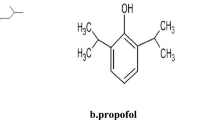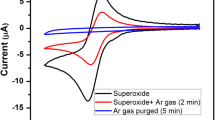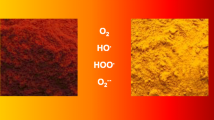Abstract
The elimination of superoxide anion free radical O ·−2 by the complexes of quercetin and physiological metal ions has been investigated theoretically. It turns out that Ca(II) and Zn(II) quercetin complexes are mild and efficient reagent on O ·−2 fixing, and Fe(II) and Ni(II) quercetin complexes are excellent reagent on O ·−2 elimination, and Cu(II) and Co(II) quercetin complexes are mainly no effect on O ·−2 , which is consistent with some experiments, and Cu(I) and Co(I) complexes are active on O ·−2 elimination on some sites of –OH. Some metal ion complexes herein only have one active center on metal ion itself, and none of their OH sites is active on O ·−2 fixing such as Cr(III) and Fe(III) and Mn(II). The possible transition states of the interaction between quercetin molecule and O ·−2 on different OH sites also have been investigated. We get the similar transition states for different OH sites, the activation energy is heavily high from reactants to transition states, and the transition states are near to the final products, which indicates that though the quercetin molecule can eliminate O ·−2 , metal ions quercetin complexes are quite good at it, and some complexes can eliminate more than one O ·−2 at the same time, which may be the potential effective medicines for O ·−2 elimination to protect β cells from O ·−2 attacking and helpful for diabetics and other relative diseases.










Similar content being viewed by others
References
Guo JK, Chen Y, Yuan B, Liu ST, Rao PF (2011) Effects of intracellular superoxide removal at acupoints with TAT-SOD on obesity. Free Radic Biol Med 51:2185–2189
An L, Feng F (2015) Network pharmacology-based antioxidant effect study of Zhi-Zi-Da-Huang Decoction for alcoholic liver disease. Evid Based Complement Altern Med 2015:1–6
Tartaro Bujak I, Chryssostomos C, Mihalijevic B (2012) The influence of antioxidants in the thiyl radical induced lipid peroxidation and isomerization processes in linoleic acid micelles. Free Radic Biol Med 53:S139–S140
Li B, Li Y, Hu Q (2016) Antioxidant activity of flavonoids from tartary buckwheat bran. Toxicol Environ Chem 98:429–438
Wybranowski T, Ziomkowska B, Kruszewski S (2013) Antioxidant properties of flavonoids and honeys studied by optical spectroscopy methods. Med Biol Sci 27:53–58
Wan C, Yu Y, Zhou S, Tian S, Cao S (2011) Isolation and identification of phenolic compounds from Gynura divaricata leaves. Philos Mag 7:101–108
Brahmachari G (2013) Chemistry and pharmacology of naturally occurring bioactive compounds. CRC Press, Boca Raton
Ravichandran R, Rajendran M, Devapiriam D (2014) Antioxidant study of quercetin and their metal complex and determination of stability constant by spectrophotometry method. Food Chem 146:472–478
Bravo A, Aancona JR (2001) Metal complexes of the flavonoid quercetin: antibacterial properties. Transit Metal Chem 26:20–23
Rubens FVS, Eliana MS, Wagner FG (2003) Synthesis, electrochemical, spectral, and antioxidant properties of complexes of flavonoids with metal ions. Synth React Inorg Metallorg Chem 33:1125–1144
Oliveira CG, Maia PIS, Miyata M, Pavan FR, Leite CQF, Almeida ET, Deflon VM (2014) Cobalt(III) complexes with thiosemicarbazones as potential anti-Mycobacterium tuberculosis agents. J Braz Chem Soc 25:1848–1856
Ghosh N, Chakraborty T, Mallick S, Mana S, Singha D, Ghosh B, Roy S (2015) Synthesis, characterization and study of antioxidant activity of quercetin-magnesium complex. Spectrochim Acta A Mol Biomol Spectrosc 151:807–813
Zhao Y, Truhlar DG (2008) The M06 suite of density functionals for main group thermochemistry, thermochemical kinetics, noncovalent interactions, excited states, and transition elements: two new functionals and systematic testing of four M06-class functionals and 12 other functionals. Theor Chem Acc 120:215–241
Peverati R, Truhlar DG (2012) Screened-exchange density functionals with broad accuracy for chemistry and solid-state physics. Phys Chem Chem Phys 14:16187–161891
Chai JD, Headgordon M (2008) Long-range corrected hybrid density functionals with damped atom-atom dispersion corrections. Phys Chem Chem Phys 10:6615–6620
Patra M, Mukheriee R, Banik M, Dutta D, Begum N, Basu T (2017) Calcium Phosphate-Quercetin Nanocomposite (CPQN): a multi-functional nanoparticle having pH indicating, highly fluorescent and anti-oxidant properties. Colloid Surf B Biointerfaces 154:63–73
Azeez L, Oyedeji AO, Adewuyi SO, Tijani KO (2016) Syntheses, characterization and antioxidant activities of copper complexes of quercetin as influenced by redox states. Int J Biol Chem Sci 9(5):2721–2727
Flora SJ (2009) Structural, chemical and biological aspects of antioxidants for strategies against metal and metalloid exposure. Oxidative Med Cell Longev 2:191–206
Li F (2004) Study on relation of molecular structure-bioactivity and cooperative action for flavonoid coordination complexes, Ph.D. thesis. Si Chuan University, Chengdu
Bukhari SB, Memon S, Tahir MM, Bhanger MI (2008) Synthesis, characterization and investigation of antioxidant activity of cobalt–quercetin complex. J Mol Struct 892:39–46
Selvaraj S, Krishnaswamy S, Devashya V, Sethuraman S, Krishnan UM (2014) Flavonoid-metal ion complexes: a novel class of therapeutic agents. Med Res Rev 34:677–702
Raza A, Xu X, Xia L, Xia C, Tang J, Ouyang Z (2016) Quercetin-iron complex: synthesis, characterization, antioxidant, DNA binding, DNA cleavage, and antibacterial activity studies. J Fluoresc 26:2023–2031
Kalinowska M, Świderski G, Matejczyk M, Lewandowski W (2016) Spectroscopic, thermogravimetric and biological studies of Na(I), Ni(II) and Zn(II) complexes of quercetin. J Therm Anal Calorim 126(1):141–148
Romo CR, Arancibia V, Costa DM, Tapia RA (2016) Highly sensitive determination of vanadium (V) by catalytic adsorptive stripping voltammetry. Substituent effect on sensitivity III. Sens Actuator B 224:772–779
Cazarolli LH, Zanatta L, Jorge AP, de SousaE Horst H, Woehl VM, Pizzolatti MG, Szpoganicz B, Silva FR (2006) Follow-up studies on glycosylated flavonoids and their complexes with vanadium: their anti-hyperglycemic potential role in diabetes. Chemico Biol Interact 163:177–191
Halder S, Kar R, Mehta AK, Bhattacharya SK, Mediratta PK, Banerjee BD (2015) Quercetin modulates the effects of chromium exposure on learning, memory and antioxidant enzyme activity in F1 generation mice. Bio Trace Elem Res 171:391–398
Miertus S, Scrocco E, Tomasi J (1981) Electrostatic interaction of a solute with a continuum. A direct utilizaion of AB initio molecular potentials for the prevision of solvent effects. Chem Phys 55:117–129
Mennucci B, Tomasi J (1997) Continuum solvation models: a new approach to the problem of solute’s charge distribution and cavity boundaries. J Chem Phys 106:5151–5158
Frisch MJ, Trucks GW, Schlegel HB, Scuseria GE, Robb MA, Cheeseman JR, Scalmani G, Barone V, Mennucci B, Petersson GA, Nakatsuji H, Caricato M, Li X, Hratchian HP, Izmaylov AF, Bloino J, Zheng G, Sonnenberg JL, Hada M, Ehara M, Toyota K, Fukuda R, Hasegawa J, Ishida M, Nakajima T, Honda Y, Kitao O, Nakai H, Vreven T, Montgomery JA Jr, Peralta JE, Ogliaro F, Bearpark M, Heyd JJ, Brothers E, Kudin KN, Staroverov VN, Kobayashi R, Normand J, Raghavachari K, Rendell A, Burant JC, Iyengar SS, Tomasi J, Cossi M, Rega N, Millam JM, Klene M, Knox JE, Cross JB, Bakken V, Adamo C, Jaramillo J, Gomperts R, Stratmann RE, Yazyev O, Austin AJ, Cammi R, Pomelli C, Ochterski JW, Martin RL, Morokuma K, Zakrzewski VG, Voth GA, Salvador P, Dannenberg JJ, Dapprich S, Daniels AD, Farkas O, Foresman JB, Ortiz JV, Cioslowski J, Fox DJ (2009) Gaussian 03, revision D.02. Gaussian Inc., Wallingford
Lee C, Yang W, Parr RG (1988) Development of the Colle-Salvetti correlation energy formula into a functional of the electron density. Phys Rev B 37:785–789
Hay PJ, Wadt WR (1985) Ab initio effective core potentials for molecular calculations. Potentials for the transition metal atoms Sc to Hg. J Chem Phys 82:270–283
Hay PJ, Wadt WR (1985) Ab initio effective core potentials for molecular calculations. Potentials for main group elements Na to Bi. J Chem Phys 82:284–298
Hay PJ, Wadt WR (1985) Ab initio effective core potentials for molecular calculations. Potentials for K to Au including the outermost core orbitals. J Chem Phys 82:299–310
Dill JD, Pople JA (1975) Self-consistent molecular orbital methods. XV. Extended Gaussian-type basis sets for lithium, beryllium, and boron. J Chem Phys 62:2921–2923
Primikyri A, Mazzone G, Lekka C, Tzakos A, Russo N, Gerothanassis IP (2015) Understanding Zinc(II) chelation with quercetin and luteolin: a combined NMR and theoretical study. J Phys Chem B 119(1):83–95
Fiedler AT, Fischer AA (2016) Oxygen activation by mononuclear Mn Co, and Ni centers in biology and synthetic complexes. J Bio Inorg Chem 22:407–424
Acknowledgements
Financial support from the Natural Science Foundation of Inner Mongolia Autonomous Region (No. 2014MS0214) and the NSFC (No. 21563002) are gratefully acknowledged.
Author information
Authors and Affiliations
Corresponding authors
Electronic supplementary material
Below is the link to the electronic supplementary material.
Rights and permissions
About this article
Cite this article
Luo, D., Wang, Y.A. Theoretical investigation of the superoxide anion free radical elimination by quercetin–metal complexes. Theor Chem Acc 137, 71 (2018). https://doi.org/10.1007/s00214-018-2248-6
Received:
Accepted:
Published:
DOI: https://doi.org/10.1007/s00214-018-2248-6




